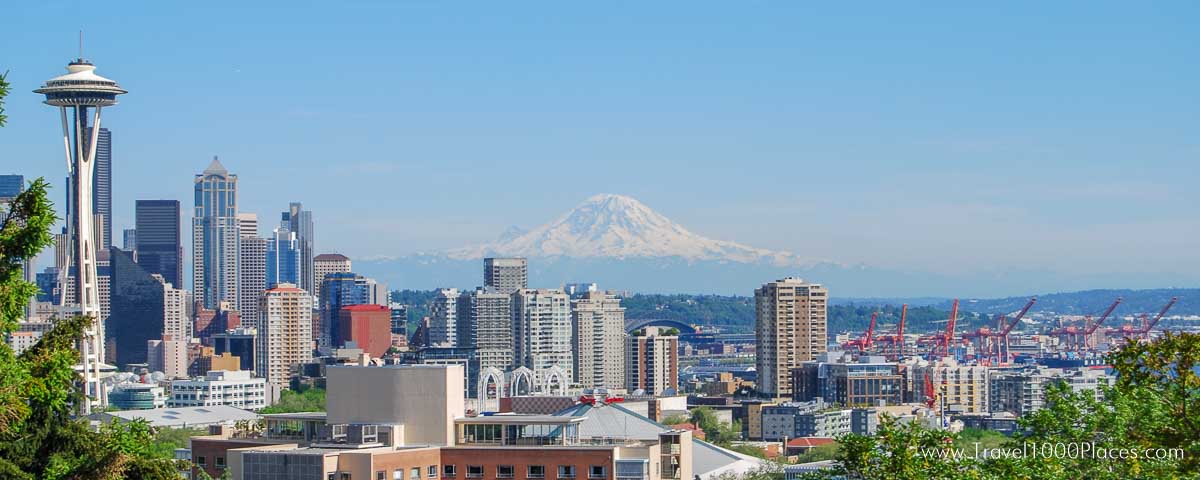
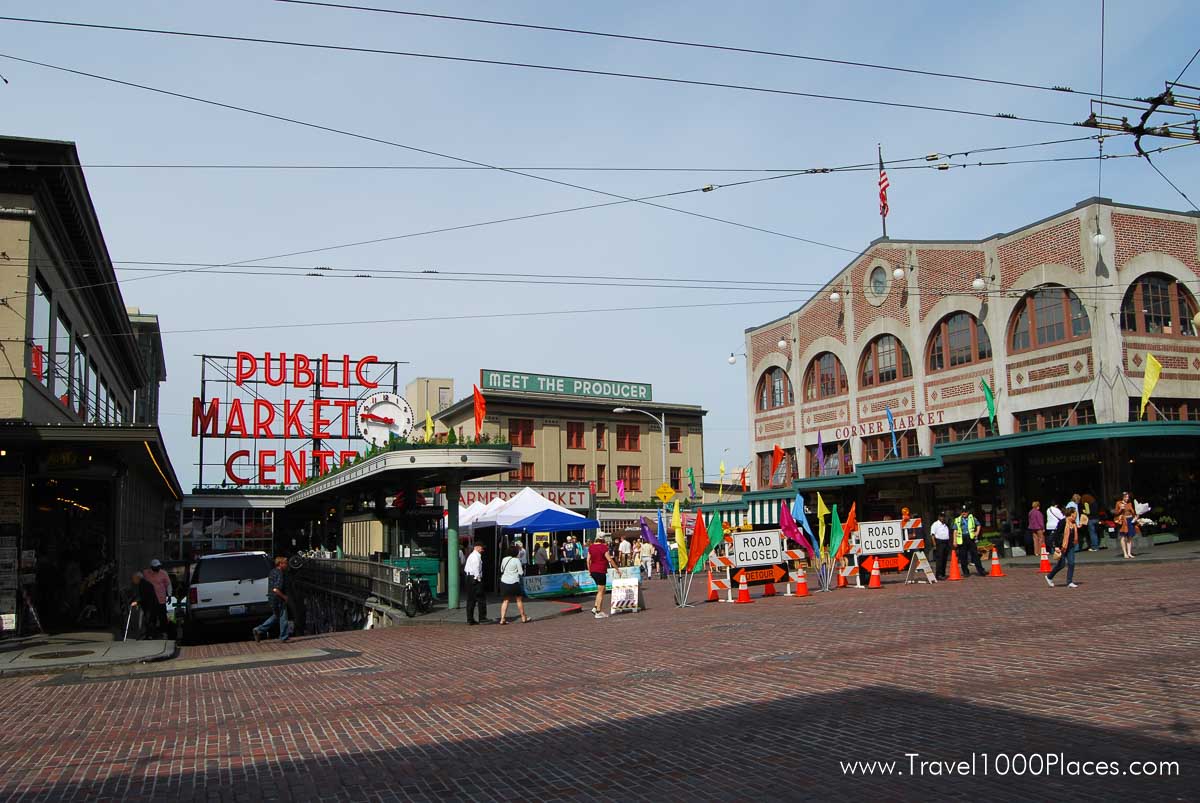
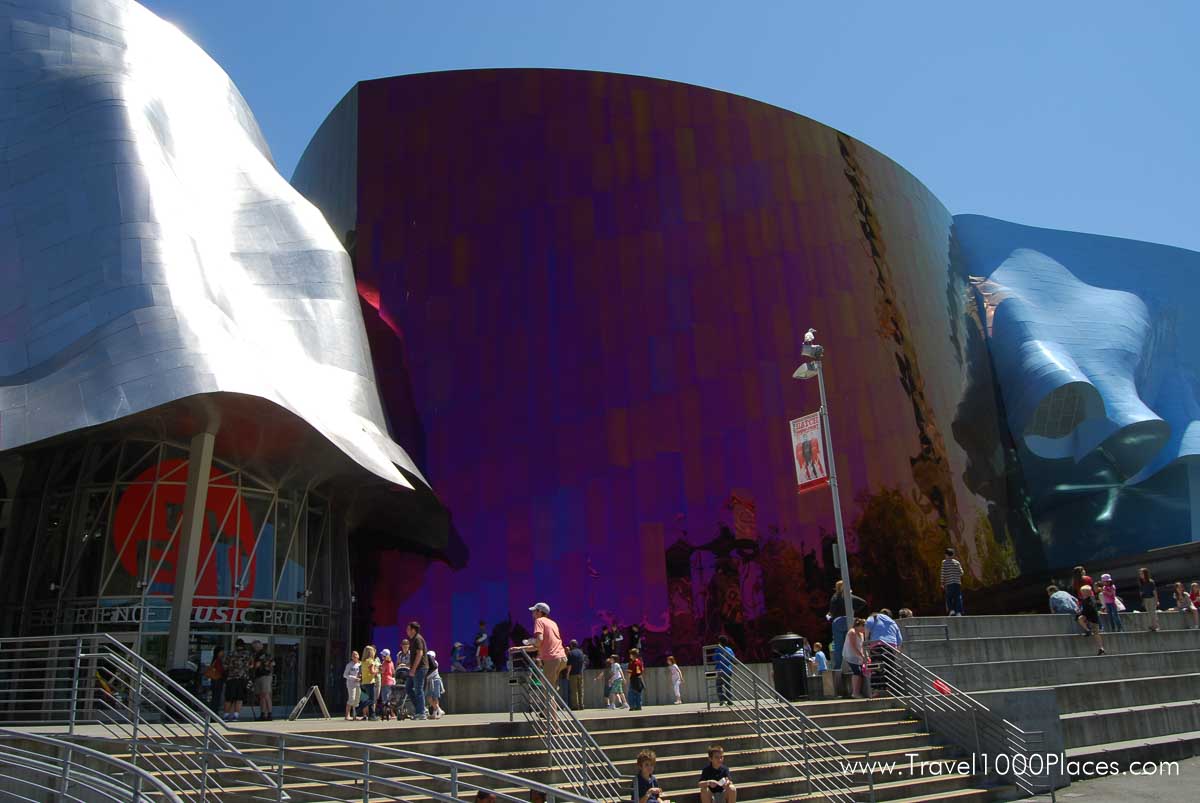
Overview
- Pike Place Farmers Market
- Space Needle
- Hammering Man
- Pioneer Square
- Tours from Seattle’s Waterfront
- Seattle Center
- The Seattle Waterfront
- Chinatown-International District
Museums
- The Children’s Museum
- Experience Music Science Fiction
- Museum and Hall of Fame
- Henry Art Gallery
- Klondike Goldrush National Historic Park
- Museum of Flight
- Museum of Glass: International Center
- or Contemporary Art
- Odyssey Maritime Discovery Center
- Pacific Science Center & Seattle Aquarium
- Seattle Art Museum & Seattle Asian Art Museum
- Olympic Sculpture Park
- Smith Tower Observation Deck
Overview information of Seattle, including weather, data & facts, airport, transportation… see our article: Seattle, Washington State — Overview for travelers
Map Seattle
Space Needle
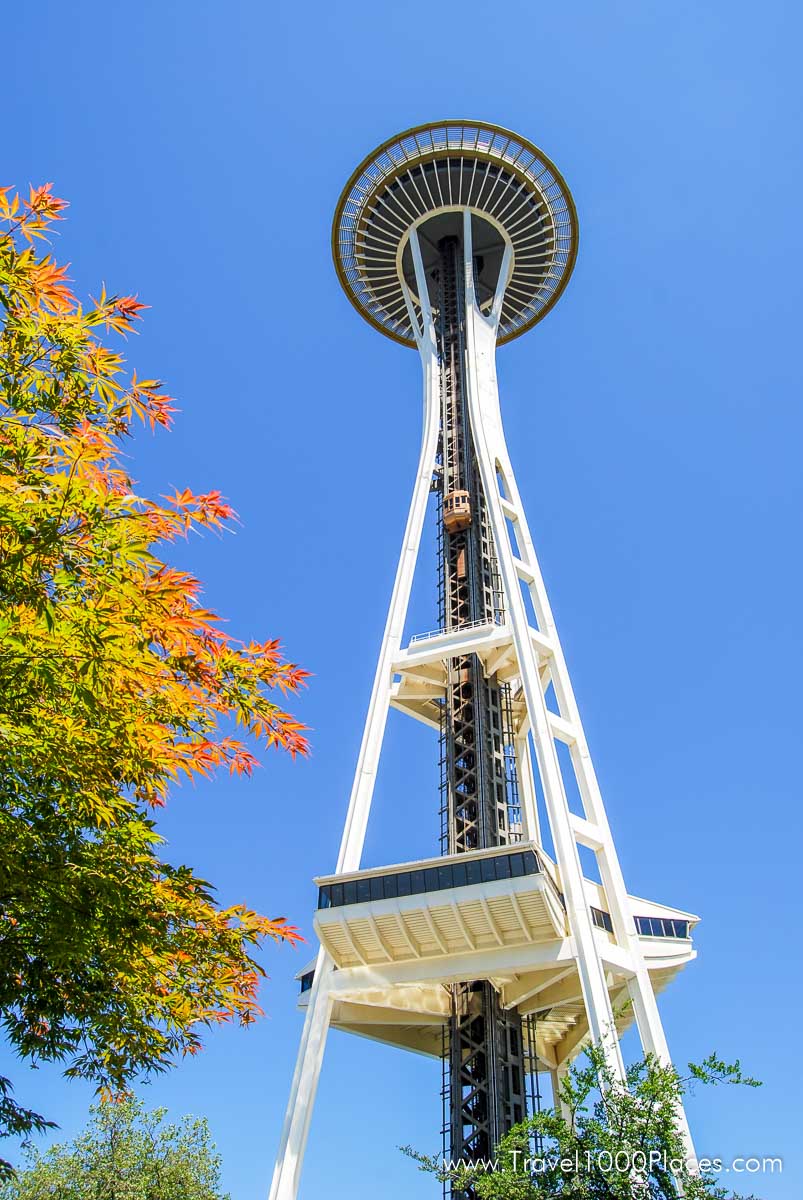
A legacy of the 1962 Seattle World’s Fair, the 605-foot Space Needle observation tower is an ever-futuristic icon of Seattle. The Space Needle features an observation deck at the 520-foot level with 360-degree views of the Seattle skyline, Puget Sound and the Cascade and Olympic Mountains. Just below, SkyCity restaurant rotates on the hour and specializes in Pacific Northwest cuisine. A gift store is located in the Space Needle lobby.
Built in 1962 for the Seattle World’s Fair, the rotating 607-ft. Space Needle was hailed as futuristic and daring. Now this internationally recognized symbol of Seattle (which, by the way, held its own during the 7.6 earthquake in February, 2001) is a quirky reminder of the city’s creative spirit. In 1962,when the Space Needle was built, it was the tallest building west of the Mississippi.
In 41 seconds, you’ll go from ground level to the 607-foot Space Needle observation towerwhich features a beautiful panorama of Seattle’s natural wonders such as the Cascade Mountains and Mt. Rainier, as well as Elliot Bay and much more.
Pike Place Farmers Market
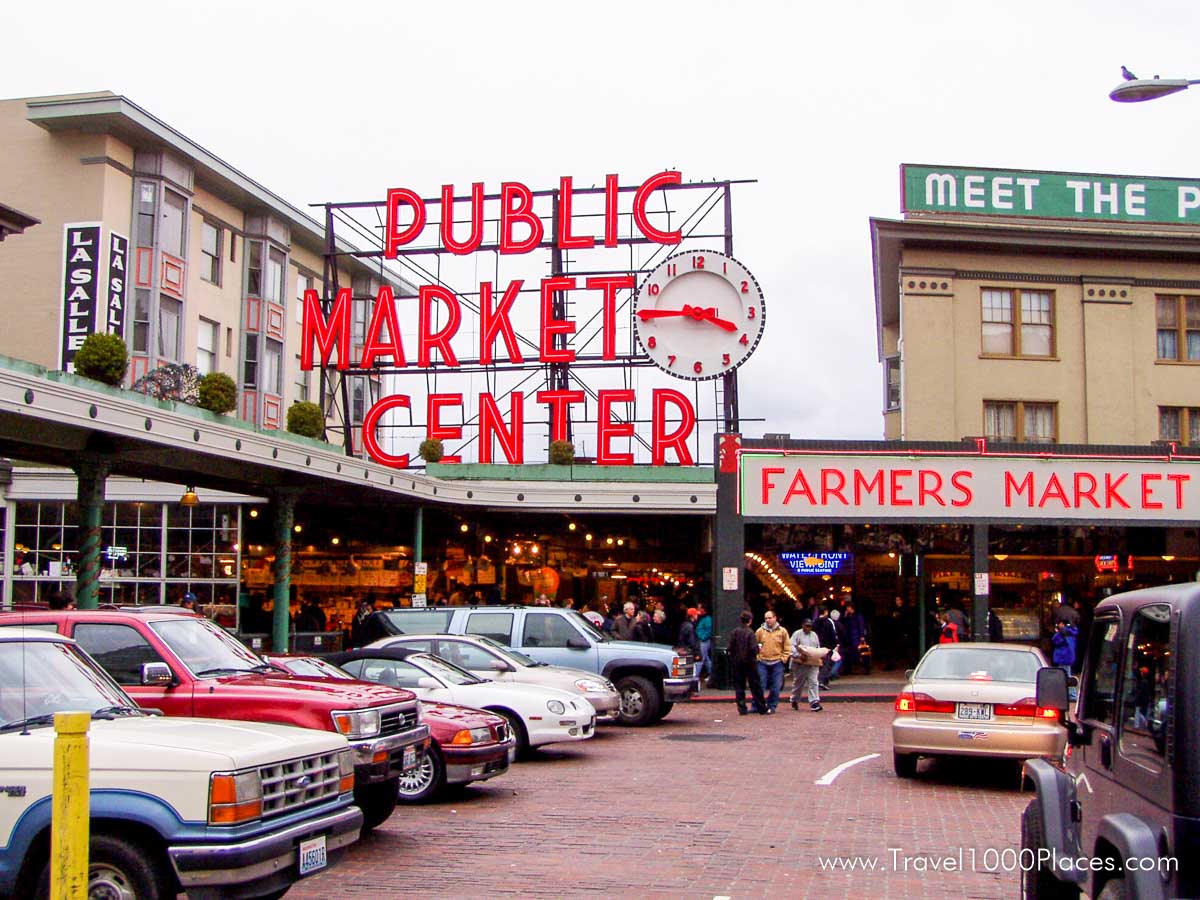
The nation’s oldest continually working farmer’s market (since 1907), Pike Place is a tribute to the Seattleites who saved it from corporate takeover in the early ’70s.
With customary pluck, they established guiding principles that remain true to the market’s agrarian roots and maintain its integrity. The result is a jubilant, open-air celebration of fresh regional fruits and vegetables, seasonal flowers, herbs, seafood, spices, cheeses, hand-crafted work by artisans, eclectic shops, and fine restaurants and eateriesm many with views of ferry and freighter traffic on Elliott Bay.
Here in this revered nine-acre community with its cracked walkways and uneven cobblestone streets, the scent of sweet peas mingles with Dungeness crabs and spicy teas, street musicians compete with “free sample!” vendors, and weird things make their appearance: bottom-dwelling monkfish and rubber-necked geoducks.
A piscatorial highlight: Pike Place Fish, where world-famous fishmongers have elevated salmon-slinging to new heights.
OVERVIEW
Pike Place Market is Seattle’s iconic public market, with more than 15 million visitors exploring the nine-acre historic district annually. Founded in August 1907, the Market operates one of the longest running farmers markets in the U.S. and continues to advocate for the preservation of regional farmland. The bustling year-round market is an urban
village of more than 500 small independent businesses, including farmers, craftspeople, butchers, fish markets, shops, bakeries, restaurants and specialty food stores. There are more than 450 low-income residents who live in the Market, many in apartments above popular storefronts. Social services in the Market help support these residents, many of whom are seniors.
Web: Pike Place Market
Map Pike Place Market
Pioneer Square
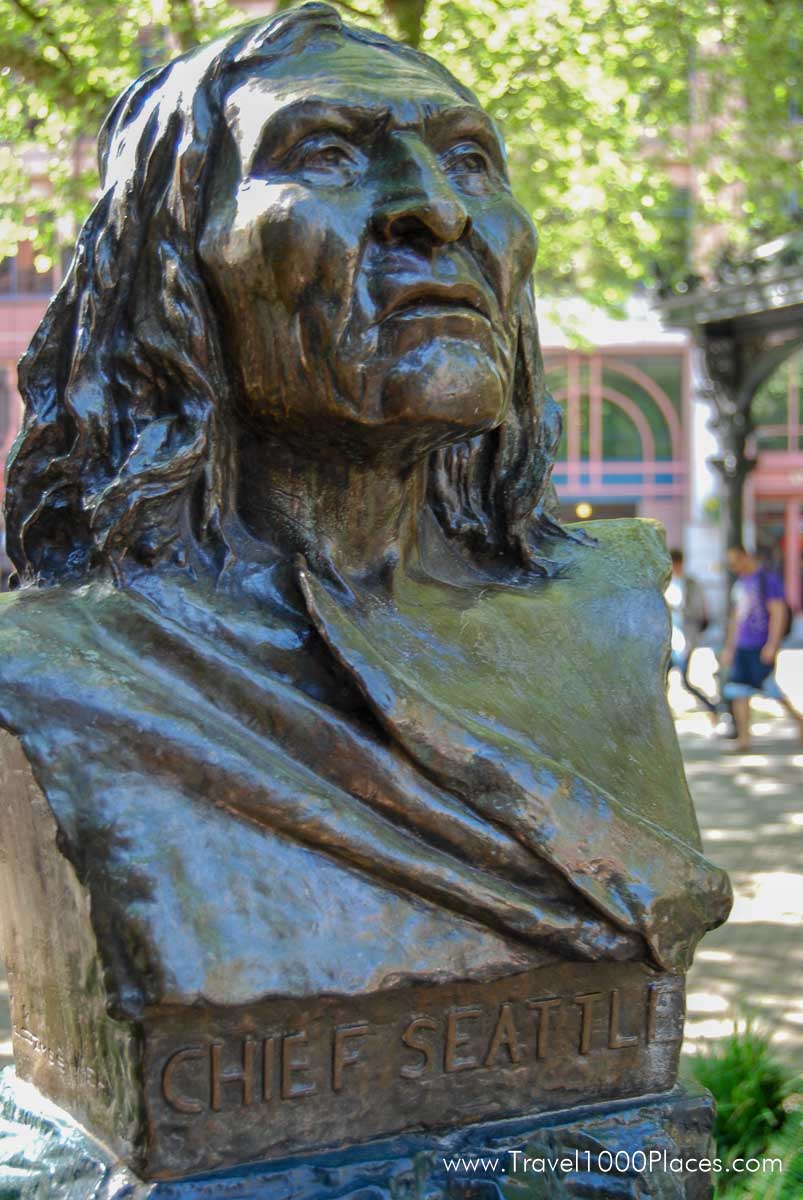
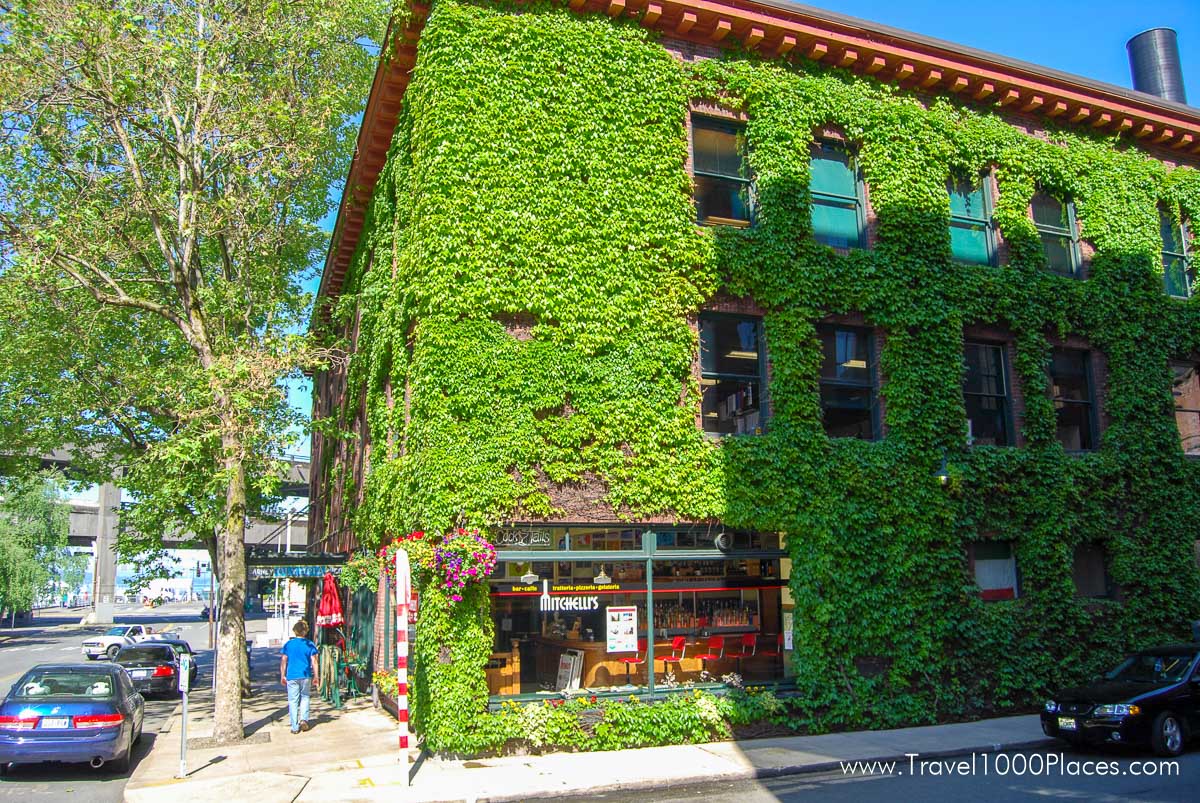
Seattle’s historic district, located on the southern fringe of the downtown business core, features some 20 square blocks of Victorian Romanesque architecture, museums, the city’s highest concentration of art galleries, many restaurants – and a rip-roaring nightlife. But then, Pioneer Square’s history offers many a wild tale.
As a young lumber town in the 1800’s, logs skidded down its streets to harbor side sawmills. The town’s brisk growth was suddenly halted by a great fire in 1889 that destroyed many of its wooden structures. The town was quickly rebuilt with brick and mortar atop the rubble and Seattle boomed again as a primary staging area for the Klondike Gold Rush in the 1890’s when more than 70,000 prospectors passed through town. Today, visitors are still drawn to Pioneer Square.
The Underground Tour offers a look at the remnants of the old town below street level. The Klondike Gold Rush National Historic Park interprets Seattle’s role critical role in the gold rush. And antique-hunters, gallery-walkers and bar-hoppers keep the neighborhood bustling. Visit www.pioneersquare.org for more background.
Seattle’s preserved historic district, lies adjacent to the southern end of the downtown waterfront.
Here the city has its roots centered around the original Skid Road (Yesler Way), a road used to skid timber down from the hills to Elliott Bay.
Many of the fine old brick and sandstone buildings have been painstakingly restored in recent years and a half-dozen square blocks of the district offer excellent shopping and dining.
The Underground Tours that go beneath the current-day Pioneer Square cobblestones provide a glimpse of Seattle, circa 1890.
Map Pioneer Square
Seattle Waterfront
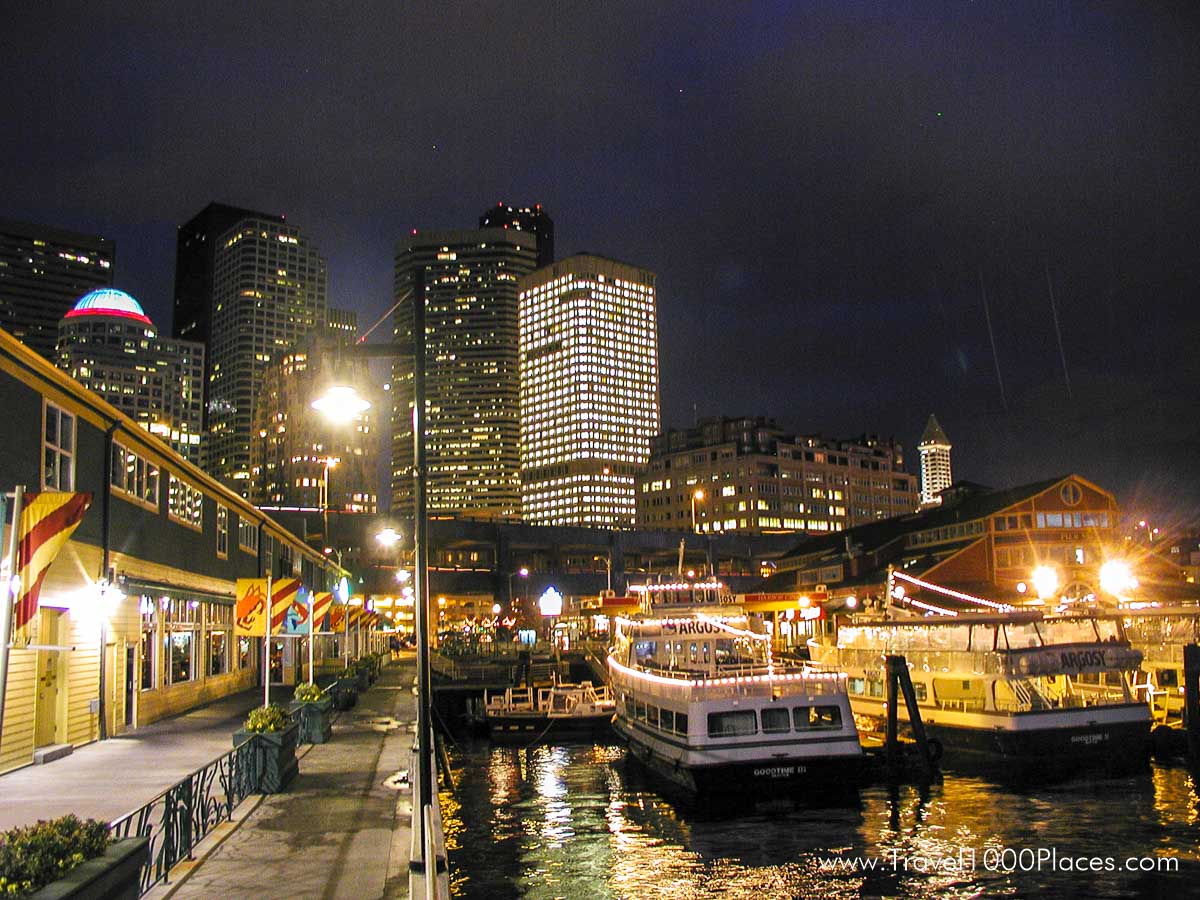
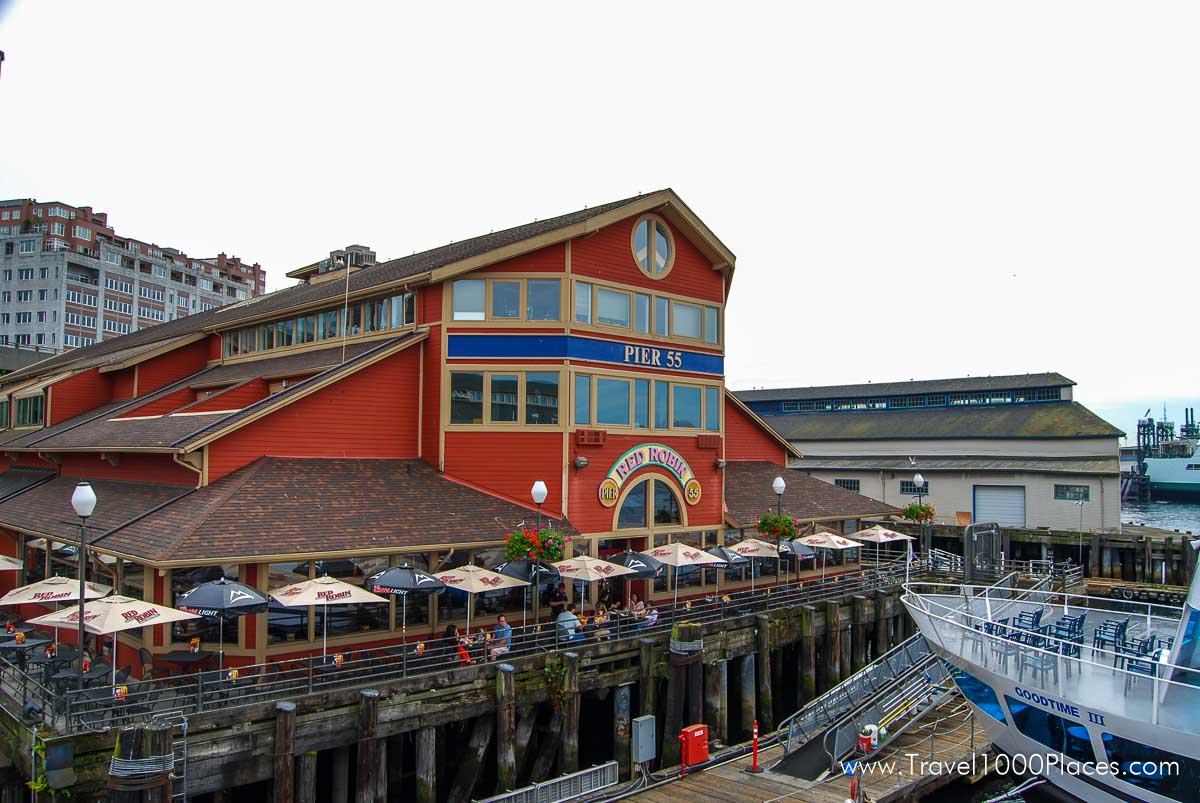
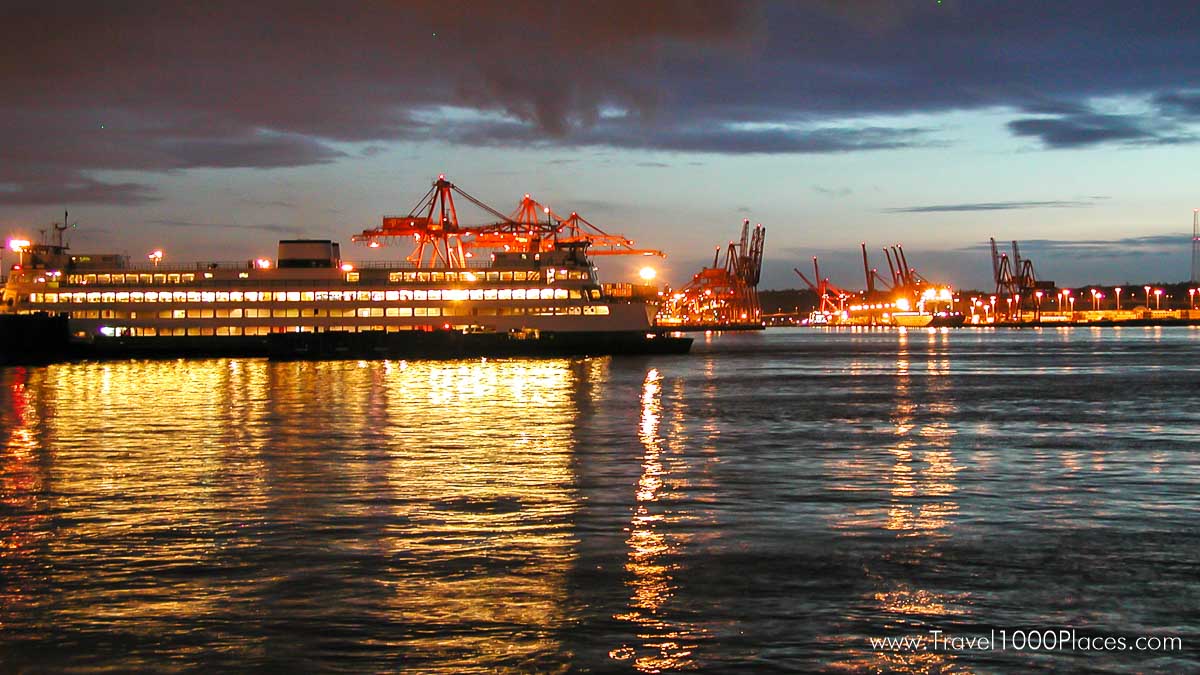
Seattle’s natural deep-water harbor, Elliott Bay, teems with trade, ferry boats, luxury cruise liners, sightseeing tour boats and myriad pleasure craft. Prime harbor views can be found on the city’s central waterfront, stretching along Alaskan Way from Pier 70 on the north to Pier 48 on the south. Midway, built atop Pier 59 is the Seattle Aquarium. The Odyssey Maritime Discovery Center at Pier 66 explores the busy bay beyond its doors. The pier is also home to the Bell Street Cruise Terminal, homeport for luxury cruise liners bound for Alaska’s Inside Passage (a second cruise ship terminal at Pier 48).
At Pier 55 and 56, Argosy Cruises features decidedly smaller vessels for sightseeing trips and evening dinner cruises. Also departing from Pier 55, Tillicum Village offers a scenic boat trip to nearby Blake Island for a Northwest Coast Native American stage show. The Seattle Waterfront also features souvenir and gift shops and an array of Northwest seafood dining.
A vintage trolley system connects the waterfront with Pioneer Square and the Chinatown-International District.
Seattle Center
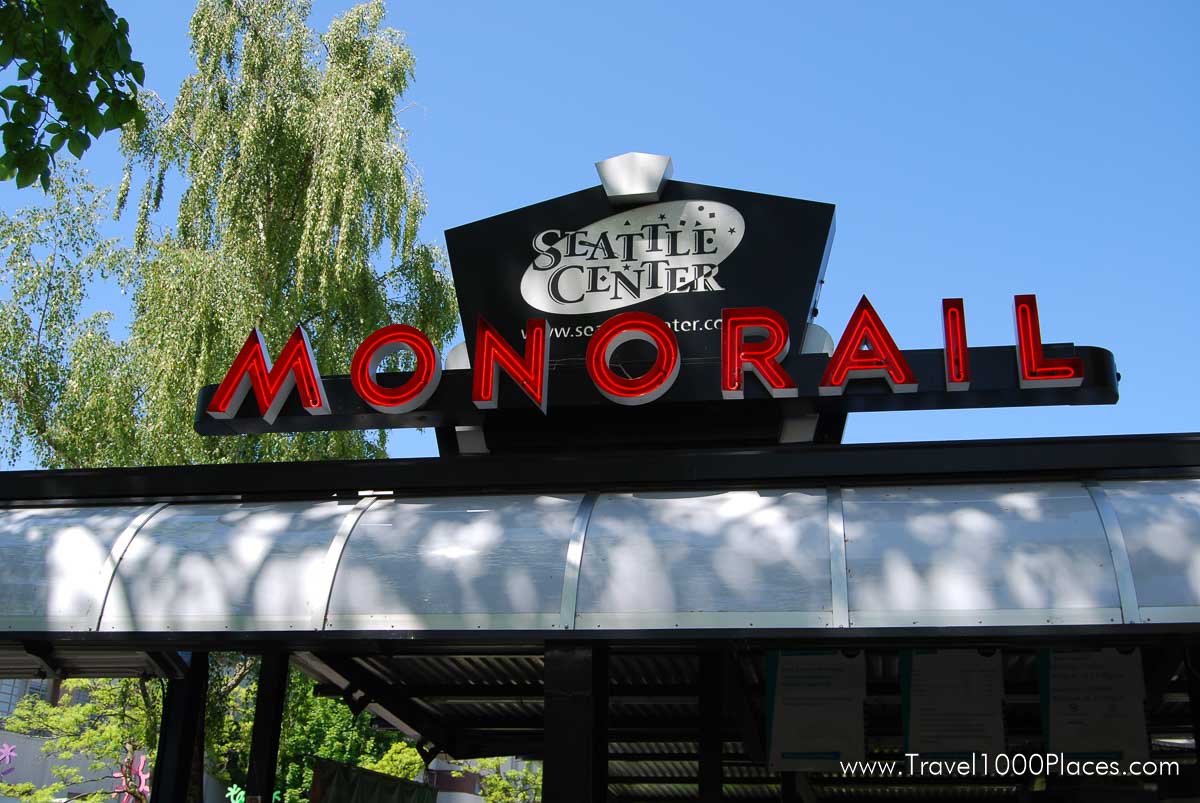
The legacy of the 1962 Seattle World’s Fair, Seattle Center is a 74-acre urban park and home to the landmark Space Needle, Pacific Science Center, Experience Music Project, Science Fiction Museum and Hall of Fame, Seattle Opera, Pacific Northwest Ballet, Seattle Repertory Theatre, Intiman Theatre, Seattle Children’s Theatre, Seattle Children’s Museum and many other attractions.
The Seattle Center also hosts many of the city’s largest festivals, including Bumbershoot (the Seattle Arts Festival), Folklife folk art festival, the Seattle International Children’s Festival, the Bite of Seattle and many other community events. The Seattle Center is located just north of downtown Seattle in the Lower Queen Anne neighborhood at 305 Harrison Street.
Seattle Center draws you in. Its vibrant pulse brings together people of all ages and walks of life to create thousands of extraordinary experiences that enrich millions of lives each year. Entertainment options abound – starting with 63 free and low cost public programs and over 5,000 shows and events annually. The 74-acre campus, with its 17 acres of open space, is welcoming to all – and is home to more than 30 cultural, educational, sports and entertainment organizations. This treasured urban gathering place exists to delight and inspire the human spirit in each person and bring our rich and varied community together.
From downtown Seattle, visitors can take the Seattle Center Monorail from Westlake Station at Fifth Avenue and Pine Street in downtown Seattle or take a five-minute taxi ride.
Seattle Art Museum & Hammering Man
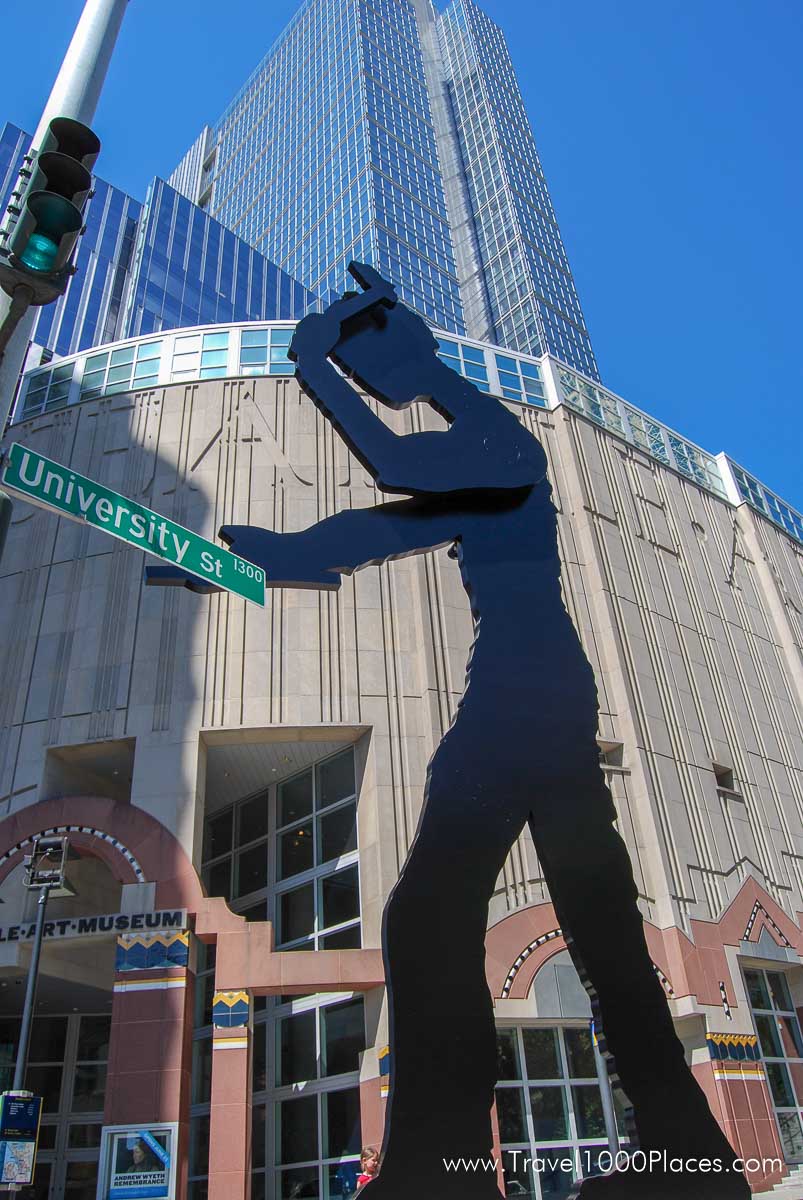
SAM – the Seattle Art Museum encompasses three parts:
SEATTLE ART MUSEUM
SEATTLE ASIAN ART MUSEUM
OLYMPIC SCULPTURE PARK
Hammering Man Statue
As part of the City of Seattle’s public arts program, The Seattle Arts Commission installed Hammering Man on September 12, 1992 at the entrance to the Robert Venturi designed Seattle Art Museum at First Avenue and University Street.
There are numerous Hammering Man sculptures of different sizes all over the world including New York, Los Angeles, Germany and Japan.
Seattle’s is 48 feet high and weighs 26,000 pounds.
Each Hammering Man is marked with a unique number.
The Hammering Man’s arm “hammers” silently and smoothly four times per minute from 7 am to 10 pm every day.
It runs on a 3-hp electric motor set on an automatic timer. Hammering Man rests its arm each evening and every year on Labor Day.
About the Artist
Jonathan Borofsky was born in Boston, Massachusetts in 1942. After graduating from Carnegie Mellon University in 1964, he studied at Ecole de Fontainbleau in Paris. In 1966 he received a Master’s degree from Yale School of Art and Architecture. Having lived and worked in New York and Los Angeles, he moved to Maine in 1992 to return to his roots on the East Coast. Over the years he has created a wide range of works in diverse materials but at the core of his endeavor lies the act of “Counting from One to Infinite,” which he began in 1969 and continues to the present. During the 1990s, he completed over 20 public art installations, including a 100-foot tall version of “Molecule Man” for the Allianz insurance company in Berlin.
He has had a one-man exhibition at the Whitney Museum of Art in New York as well as at other important museums in the world. His major monumental sculptures can be viewed in Los Angeles, Kassel Germany, Basel Switzerland and other cities.
Seattle Art Museum (SAM)
Modern in America, an installation of more than 90 works drawn from SAM’s permanent collection, is a selective survey of American modernist movements from 1905 to the present day.
View from here: The Pacific Northwest 1870-1940: a provocative assembly of perspectives of the Northwest. The exhibition presents an updated selection of approximately 40 paintings, photographs, prints and examples of Native American art from local and SAM’s permanent collection.
Seattle Asian Art Museum
Discovering Buddhist Art – Seeking the Sublime
The Seattle Asian Art Museum will feature artworks created in association with Buddhism in Discovering Buddhist Art-Seeking the Sublime, an ongoing Collection Insight exhibition.
Website with Map & Guide: Asian Art Museum (seattleartmuseum.org)
Olympic Sculpture Park
This nine-acre sculpture park features a 2,500-foot descending, Z-shaped path connecting the Belltown neighborhood in downtown Seattle with a beach on the waterfront. The path takes visitors past a range of permanent and rotating sculptures and major works by world-renowned artists such as Richard Serra, Alexander Calder and Mark di Suvero, while allowing visitors to take in the scenery offered by Puget Sound and the Olympic Mountains. The park also features the PACCAR Pavilion, a glass and steel structure that houses a fluctuating exhibit, public event space as well as a café.
The Gates Amphitheater sits adjacent to the pavilion, featuring descending grass terraces for outdoor films and performances. The Olympic Sculpture Park is open to the public, free of charge.
2901 Western Avenue Seattle, WA 98121
Website with Map & Guide: Olympic Sculpture Park (seattleartmuseum.org)
SAM — on the web: explore locations, fees, and other information
Web: SAM – Seattle Art Museum, Asian Art Museum & Olympic Sculpture Park
Smith Tower Observation Deck
![Smith Tower, with Seahawks Stadium and Mt. Rainer in the background; taken from the roof of the Pacific Building [Christopher S. Maloney (NorthLights), CC BY 2.5 https://creativecommons.org/licenses/by/2.5, via Wikimedia Commons]; edited by travel1000places.com](https://www.travel1000places.com/wp-content/uploads/2022/04/wikimedia-Smith-Tower_Seattle_WA_1280-edited-1200x800.jpg)
Once Seattle’s tallest building, Smith Tower, built in 1914 and restored in 1999, offers 360 degree views of the city, sound and mountains from its 35th floor observation deck. The deck is reached via the last remaining manual elevators on the West Coast.
No other observatory puts you in the middle of the downtown skyline or closer to Seattle’s historic waterfront. The 35th floor, outside, open-air Observation Deck wraps completely around all four sides of the historic Smith Tower providing breathtaking panoramic views of Mt. Rainier, and the Olympic and Cascade Mountain ranges. Plus, it’s the closest view in town of Safeco Field, the Colman Ferry Terminal, and Pioneer Square.
Access to the Observation Deck and Chinese Room is via the last manually operated elevators on the west coast. These brass and copper caged original 1914 elevators depart from a ground floor recently returned to its original footprint as part of a $28 million restoration. The detailed plaster and woodwork ceiling provides a colorful backdrop for the 22 larger-than-life Indian heads that watch over the onyx and marble paneled lobby.
Website: Smith Tower, Observatory & Bar
Chinatown-International District
Chinese immigrants originally landed in Seattle in the 1860s, finding work at the town’s saw mills, rail lines and on its fishing boats. Today, the Chinatown-International District spans some 44-blocks south of downtown Seattle, bound by Yesler Way and Dearborn Street on the north and south, and Interstate-5 and Fourth Avenue on the east and west.
Seattle’s Asian population has grown steadily to 13.1 percent (according to the U.S. Census Bureau, 2000 Census), and today sizable populations of Chinese, Japanese, Filipino, Korean, Vietnamese, Samoan, Laotian, Native Hawaiian and other groups all coexist in the Chinatown-International District.
The Chinatown Discovery Tour offers a guided walk through the district.
Don’t miss Uwajimaya, one of the largest Asian grocery and gift stores in the U.S. at Sixth & Weller.
MoPOP – Museum of Pop Culture

Website: MoPOP | Museum of Pop Culture in Seattle Washington (empmuseum.org)
Bubble Gum Wall
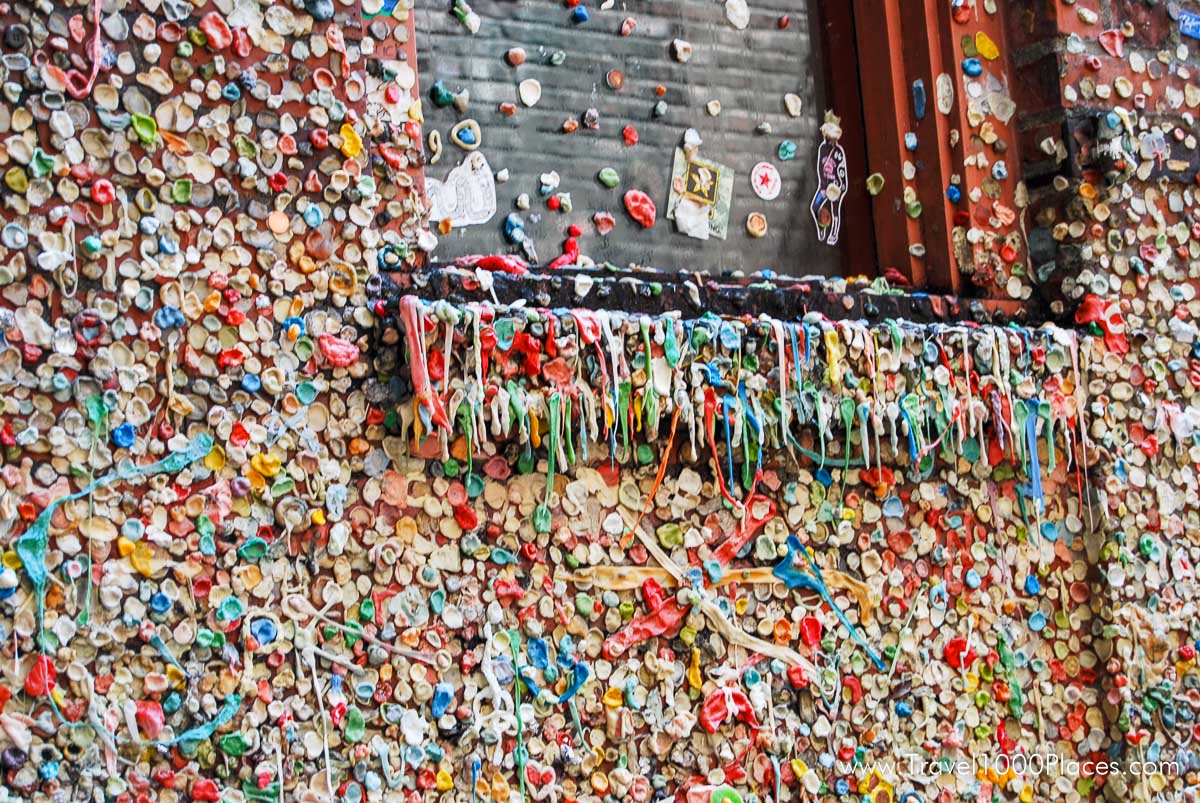
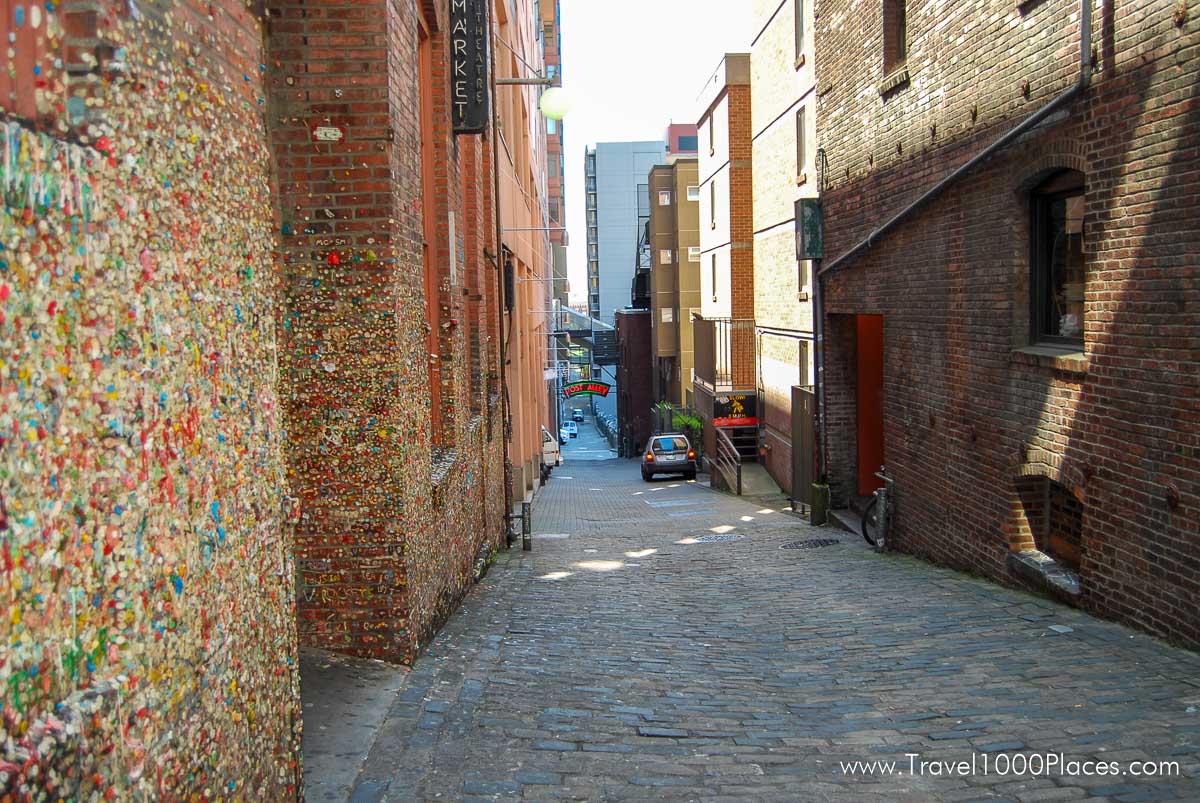
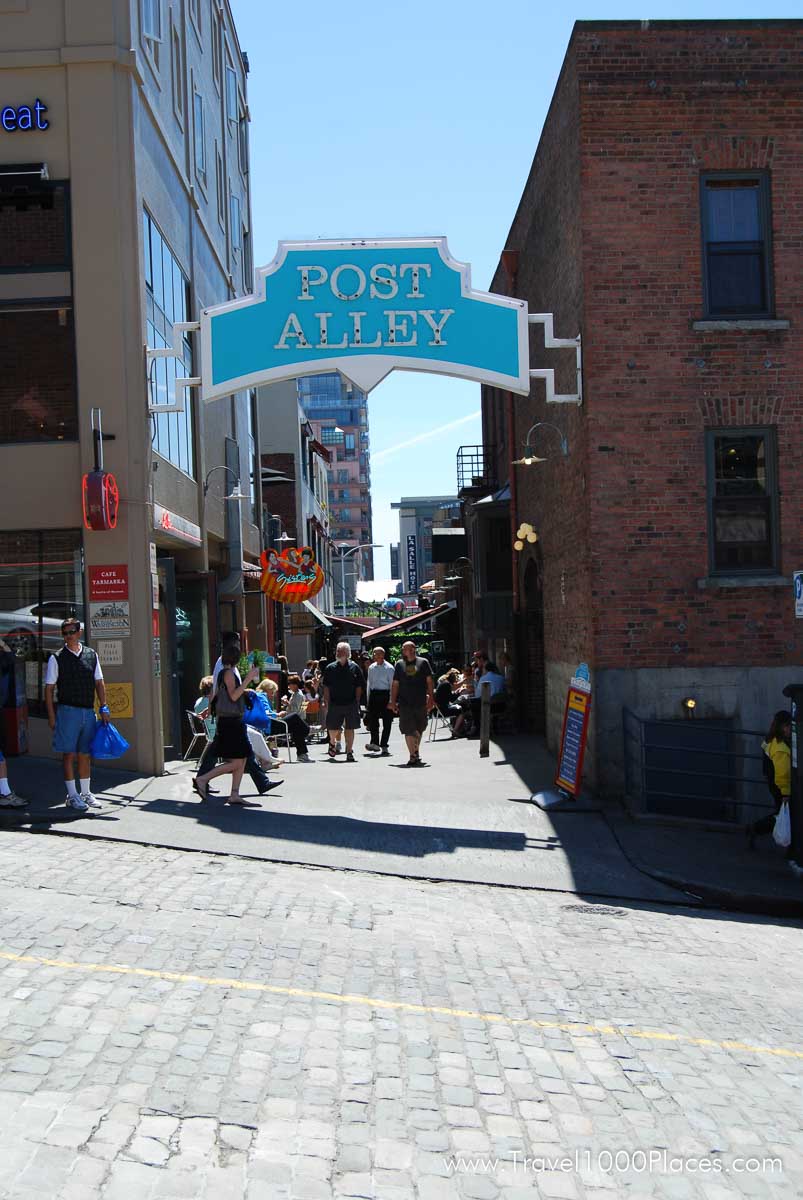
Washington Park Arboretum
The Arboretum collects, conserves and teaches about plants that are hardy to the Northwest. Its 230 acres are filled with 10,000 native plants and its landscape is an excellent setting for hands-on learning and recreation. The Arboretum is recognized as one of the most beautiful and diverse collections in the western United States.
The Washington Park Arboretum holds a world class collection of woody plants that can be explored on your own, via group tours, or through classes and activities. All parts of the Washington Park Arboretum, with the exception of the Japanese Garden, are open to the public and are free of charge. The Graham Visitors Center has maps, restrooms, Arboretum Foundation offices, a gift shop and rental venue. Year-round visitors will find something of interest along the trails that wind through 230 acres of gardens, natural areas and wetlands.
Web: Washington Park Arboretum | University of Washington Botanic Gardens (uw.edu)

